1989 MITSUBISHI GALANT air condition
[x] Cancel search: air conditionPage 956 of 1273
![MITSUBISHI GALANT 1989 Service Repair Manual ACTIVE-ELECTRONIC CONTROL SUSPENSION - Troubleshooting 33B-17
CHECKING ACCORDING TO CHARTS CLASSIFIED BY THE MALFUNCTION SYMPTOM
[A] DIAGNOSTIC TROUBLE CODE NO.54
No
Yes
b Excessive vehicle-height ad- MITSUBISHI GALANT 1989 Service Repair Manual ACTIVE-ELECTRONIC CONTROL SUSPENSION - Troubleshooting 33B-17
CHECKING ACCORDING TO CHARTS CLASSIFIED BY THE MALFUNCTION SYMPTOM
[A] DIAGNOSTIC TROUBLE CODE NO.54
No
Yes
b Excessive vehicle-height ad-](/manual-img/19/57312/w960_57312-955.png)
ACTIVE-ELECTRONIC CONTROL SUSPENSION - Troubleshooting 33B-17
CHECKING ACCORDING TO CHARTS CLASSIFIED BY THE MALFUNCTION SYMPTOM
[A] DIAGNOSTIC TROUBLE CODE NO.54
No
Yes
b Excessive vehicle-height ad-justment
(overload) overload). time (due to -Unload the vehicle and turn* the ignition key to OFF; then
restart the engine and check
whether or not the system
functions normally.
Is the installation position of Nothe height sensor correct?
Yes Improper setting of the heightc sensor, or malfunction of the
height sensor. l Correct the installationcposition of the height sen-
sor, or adjust the vehicle
-height sensor rod.
l Check the height sensor. Refer to troubleshooting
hints [IO] and
[ll]classified by circuit.
Are the front strut and rear
NoMalfunction of the rolling
shock absorber unit air spr-* diaphragm.
Repair the rolling diaphragm,
or replace the shock absorber
ings in normal condition?Lunit.
(become folded)
Yes
Is the sound of operation
NoThe solenoid valves remain
heard from each solenoid closed, or there is air leakage
valve necessary for th
e
’ due to a malfunction of the
vehicle-height adjustment? valve seat.
Yes
Is the air pressure in the
vehicle-height adjustment
Nopressure line 950 kPa (135
psi) or higher?
I
Yes Damaged or disconnected
wiring of the high-pressure
switch, or incorrect vehicle
-height adjustment pressureline.
l Check the high-pressure switch circuit.
* Refer to troubleshooting hint [5] classified by circuit.
l Correct the clogging pro-
blem, or replace the air
tube.
Control unit malfunction.
[B] DIAGNOSTIC TROUBLE CODE NO.55
- No
Does the compressor func-
tion normally?
Yes Replace the control unit.c l Power is not supplied to
the compressor.Refer to troubleshooting
hint
[18] classified by cir-
cuit.
0 Improper compressor com- pression.
Is the air pressure in the
Novehicle-height adjustment
pressure line 760 kPa (108psi) or lower? High-pressure
switch
isRefer to troubleshooting hint
shorted____* [5] classified by circuit.
Yes Air leakage.
TSB RevisionI
Page 970 of 1273

ACTIVE-ELECTRONIC CONTROL SUSPENSION - Troubleshooting 33B-31
Operation
The high-pressure switch is switched ON and OFF by the pressure in the high-pressure tank, and as a
result the ECU functions to control the activation
and stop of the compressor.
When the pressure in the high-pressure tank be-
comes 760
kPa (108 psi) or lower, the high-pressure
switch is switched ON, and as a result the ECU
sends the drive signal to the compressor. Conversely, when the pressure of the high-pressure
tank becomes 950
kPa (135 psi) or higher, the
high-pressure switch is switched OFF, and the
compressor is stopped two seconds thereafter.
Note, however, that the compressor is not ac-
tivated, even if the high-pressure switch is switched ON, if the return pump is in operation. Note also
that there is no diagnostic function for the
high-pressure switch.
Service data indication Code No
lndlcationDisDlav
15Indicates the ON/OFF status of the
high-pressure switch. 15: HIGH PRESS. SW. ON/OFF
I
ECU terminal voltages (with connector connected)
Terminal
No.Signal ConditionTermina
l
voltaaeI
59
High-pressure tank pressure signal
When high-pressure switch is ON (low pressure)
o
v
When high-pressure switch is OFF (high pressure)
5v
Checking the high-pressure switch circuit (with the connector disconnec\
ted)
Terminal Connection destination or
M
easurement
Nomeasured part Tester connection ,
Check conditionStandard
59High-pressure
switch Reststance
59-36
High-pressure tank internal
pressure 760 kPa (108 psi) orlower Continuity
High-pressure tank internalpressure 950 kPa (135 psi) orhigher
Nocontinurty
Troubleshooting hints
Malfunctlonmode
Malfunction probable cause
MalfunctionNote
TSB Revision
Harness
wlrlngdamage ordlsconnectlon
Harness wiring damage or disconnection, or
Improper switch contact Compressor doesn’t operate.-
Harnessshort-crrcuit
Air leakage. Harness short-circuit, or switch short-circuit, O-ring
worn or damaged. Compressor operates without stopplng.DiagnosticNo.55output.
Rolling control feehng
of Incompatibility. very-freauent oaeration of compressor.
Page 978 of 1273
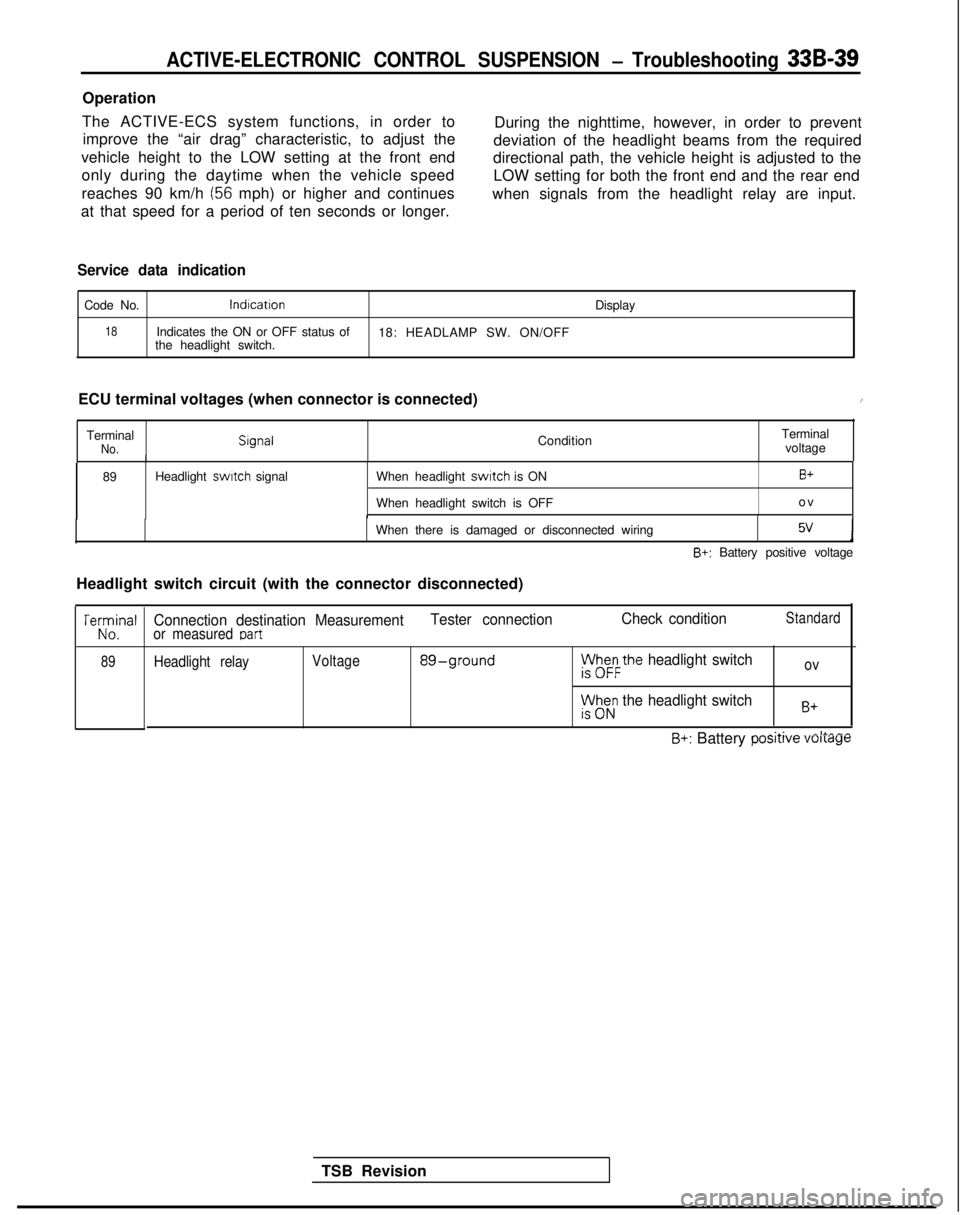
ACTIVE-ELECTRONIC CONTROL SUSPENSION - Troubleshooting 33B-39
Operation
The ACTIVE-ECS system functions, in order to improve the “air drag” characteristic, to adjust the During the nighttime, however, in order to prevent
vehicle height to the LOW setting at the front end deviation of the headlight beams from the required
only during the daytime when the vehicle speed directional path, the vehicle height is adjusted to the
reaches 90 km/h
(56 mph) or higher and continues LOW setting for both the front end and the rear end
at that speed for a period of ten seconds or longer. when signals from the headlight relay are input.
Service data indication
Code No.lndlcation
Display
18Indicates the ON or OFF status of
18: HEADLAMP SW. ON/OFF
the headlight switch.
ECU terminal voltages (when connector is connected)
/
TerminalNo. Slgnal
ConditionTerminal
voltage
89 Headlight switch
signal When headlight
switch is ON
When headlight switch is OFFB+
o
v
When there is damaged or disconnected wiring
5vJ
B+: Battery positive voltage
Headlight switch circuit (with the connector disconnected)
TSB Revision
TeKJna’
89
Connection destination Measurement Tester connectionCheck conditionStandard
or measured Dart
Headlight relayVoltage 89-groundph&the headlight switchov
rt$z; the headlight switchB+
~.A.-II___B+: Battery posrrrve voltage
Page 988 of 1273
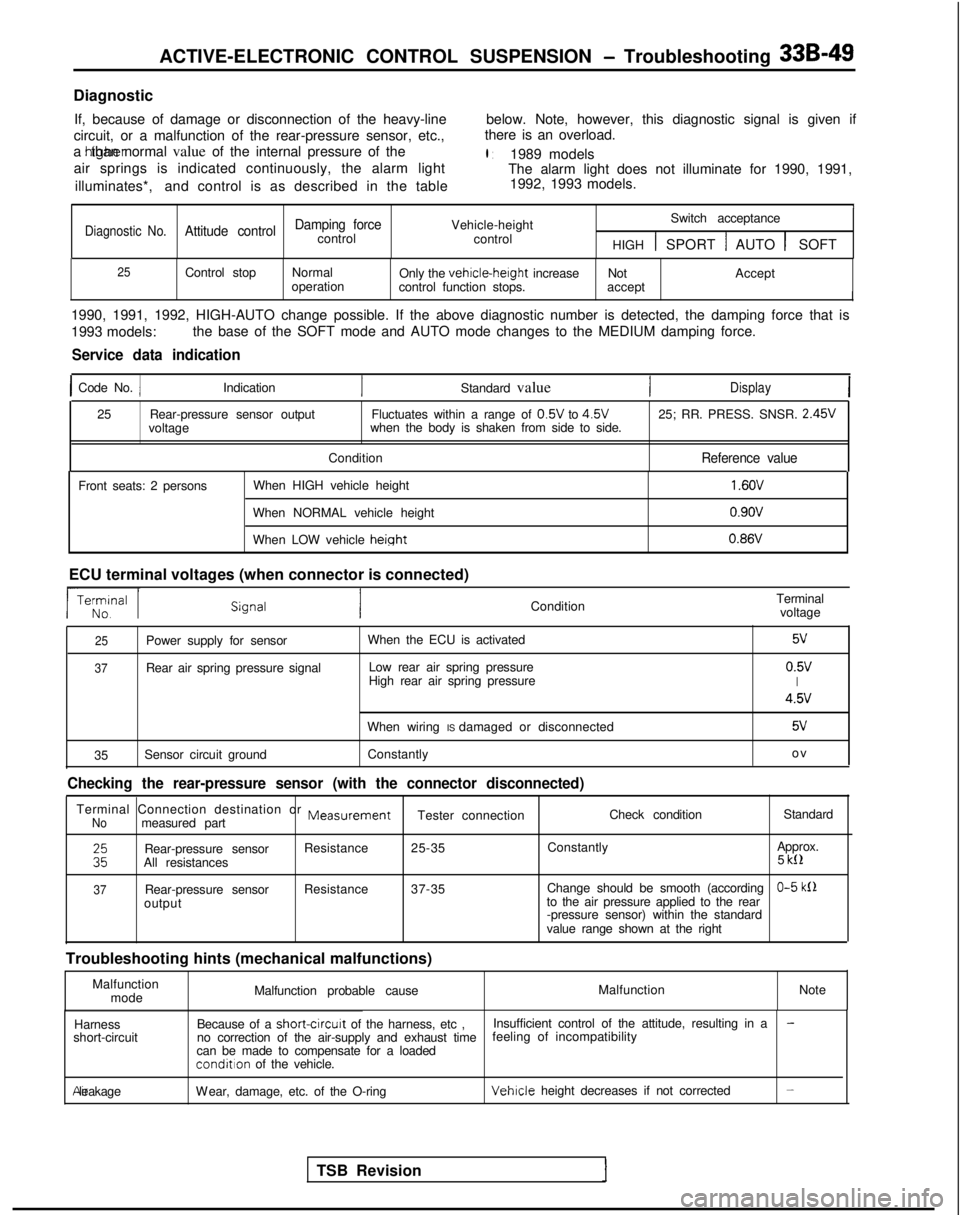
ACTIVE-ELECTRONIC CONTROL SUSPENSION - Troubleshooting 33B-49
Diagnostic
If, because of damage or disconnection of the heavy-line below. Note, however, this diagnostic signal is given if
circuit, or a malfunction of the rear-pressure sensor, etc., there is an overload.
a htgher than normal value of the internal pressure of the
l :1989 models
air springs is indicated continuously, the alarm light The alarm light does not illuminate for 1990, 1991,
illuminates*, and control is as described in the table 1992, 1993 models.
I1
Damping forceVehicle-heightSwitch acceptanceDiagnostic No.Attitude controlcontrol
control
HIGH 1 SPORT 1 AUTO 1 SOFT
25Control stopNormal
Only the vehicle-height
increase Not Accept
operation control function stops. accept
I
1990, 1991, 1992, HIGH-AUTO change possible. If the above diagnostic num\
ber is detected, the damping force that is
1993 models:the base of the SOFT mode and AUTO mode changes to the MEDIUM damping fo\
rce.
Service data indication
1 Code No. 1Indication
Standard valueDisplay
25Rear-pressure sensor output Fluctuates within a range of 0.5V
to 4.5V
25; RR. PRESS. SNSR. 2.45V
voltage when the body is shaken from side to side.
Condition
Reference value
Front seats: 2 persons When HIGH vehicle height
When NORMAL vehicle height
When LOW vehicle
height
1.6OV
0.9ov 0.86V
ECU terminal voltages (when connector is connected) ConditionTerminal
voltage
25Power supply for sensor
37Rear air spring pressure signal When the ECU is activated
Low rear air spring pressure
High rear air spring pressure
5v
0.5vI
4.5v
When wiring IS damaged or disconnected5v
35 Sensor circuit ground
Constantly o
v
Checking the rear-pressure sensor (with the connector disconnected)
Terminal Connection destination or MeasurementNomeasured part
Tester connection
Check condition
Standard
ERear-pressure sensorResistance
25-35 Constantly Approx.
All resistances 5 kll
37Rear-pressure sensor
Resistance
37-35 Change should be smooth (accordingO-5 klloutput to the air pressure applied to the rear
-pressure sensor) within the standard
value range shown at the right
Troubleshooting hints (mechanical malfunctions) Malfunctionmode Malfunction probable cause
Malfunction
Note
Harness
short-circuit Because of a short-circurt
of the harness, etc , Insufficient control of the attitude, resulting in a
-no correction of the air-supply and exhaust time feeling of incompatibility
can be made to compensate for a loaded
condition of the vehicle. Air leakage
Wear, damage, etc. of the O-ring
Vehicle height decreases if not corrected-
TSB Revision
Page 1000 of 1273
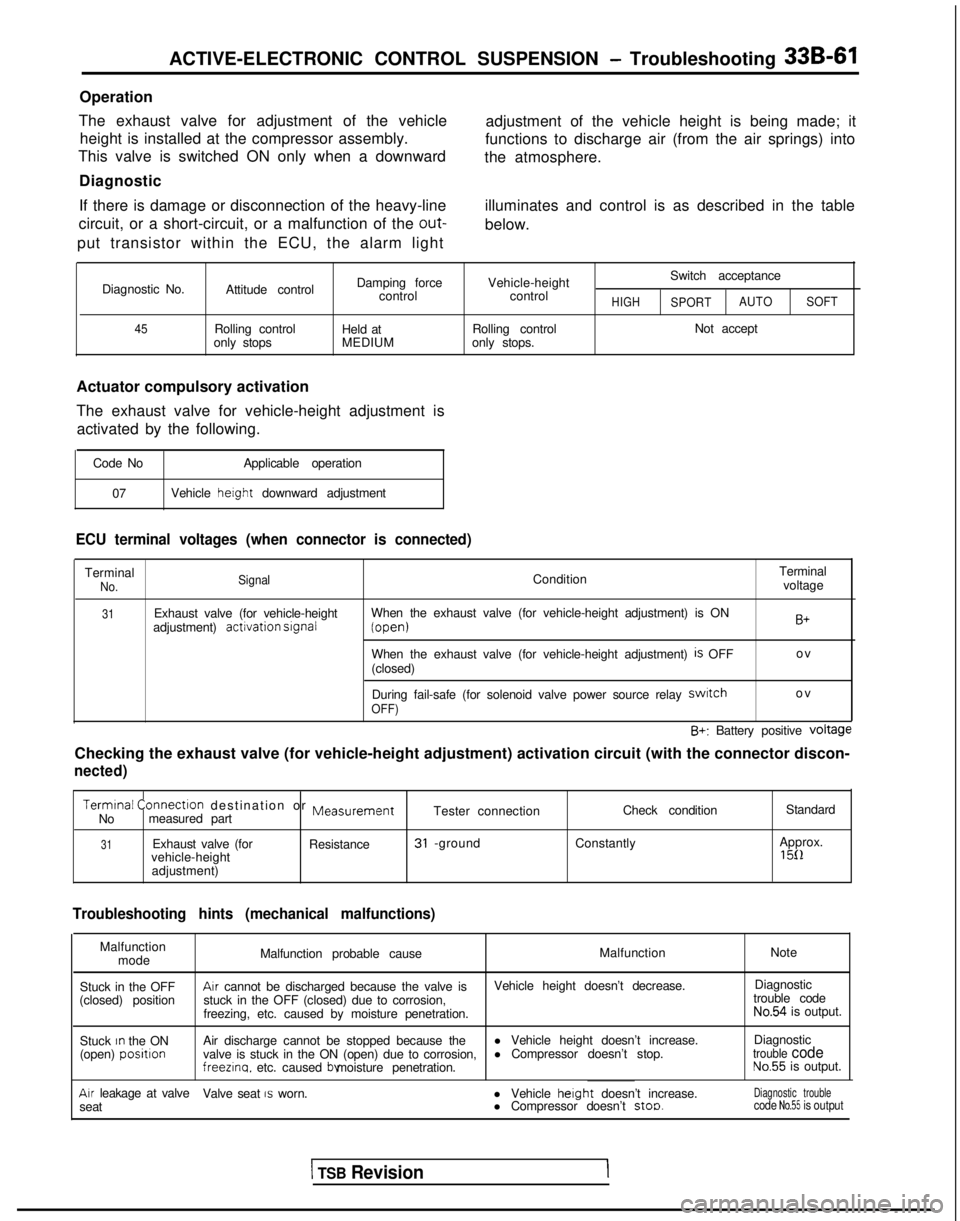
ACTIVE-ELECTRONIC CONTROL SUSPENSION - Troubleshooting 33B-61
Operation
The exhaust valve for adjustment of the vehicle height is installed at the compressor assembly.
This valve is switched ON only when a downward
Diagnostic
If there is damage or disconnection of the heavy-line
circuit, or a short-circuit, or a malfunction of the out-
put transistor within the ECU, the alarm light adjustment of the vehicle height is being made; it
functions to discharge air (from the air springs) into
the atmosphere.
illuminates and control is as described in the table
below.
Diagnostic No.
45
Attitude control
Rolling control
only stops Damping force
control
Held at
MEDIUM Vehicle-height
control
Rolling control
only stops. Switch acceptanceHIGHSPORT
AUTO
SOFT
Not accept
Actuator compulsory activation
The exhaust valve for vehicle-height adjustment is activated by the following.
Code No Applicable operation
07 Vehicle height
downward adjustment
ECU terminal voltages (when connector is connected)
TerminalNo. SignalCondition Terminal
voltage
31Exhaust valve (for vehicle-height
adjustment) activation srgnalWhen the exhaust valve (for vehicle-height adjustment) is ON (open)
When the exhaust valve (for vehicle-height adjustment)
is OFF
(closed)
B+
o
v
During fail-safe (for solenoid valve power source relay
swatcho
v
OFF)
B+: Battery positive voltage
Checking the exhaust valve (for vehicle-height adjustment) activation \
circuit (with the connector discon-
nected)
Termtnal
Connectlon destination or MeasurementCheck condition Standard
No measured part Tester connection
31Exhaust valve (for
Resistance31 -groundConstantly Approx.
vehicle-height1511adjustment)
Troubleshooting hints (mechanical malfunctions)
Malfunction mode Malfunction probable cause
Malfunction
Note
Stuck in the OFF
Arr cannot be discharged because the valve is Vehicle height doesn’t decrease.Diagnostic
(closed) position stuck in the OFF (closed) due to corrosion, trouble code
freezing, etc. caused by moisture penetration.
No.54 is output.
Stuck
rn the ON
(open) positlonAir discharge cannot be stopped because the l Vehicle height doesn’t increase.Diagnostic
valve is stuck in the ON (open) due to corrosion, l Compressor doesn’t stop.trouble codefreezlna.
etc. caused bv moisture penetration.No.55 is output.
Arr leakage at valve
Valve seat IS worn.
seat l Vehicle herght
doesn’t increase.
l Compressor doesn’t stoo.Diagnostic troublecode No.55 is output
1 TSB Revision
Page 1002 of 1273
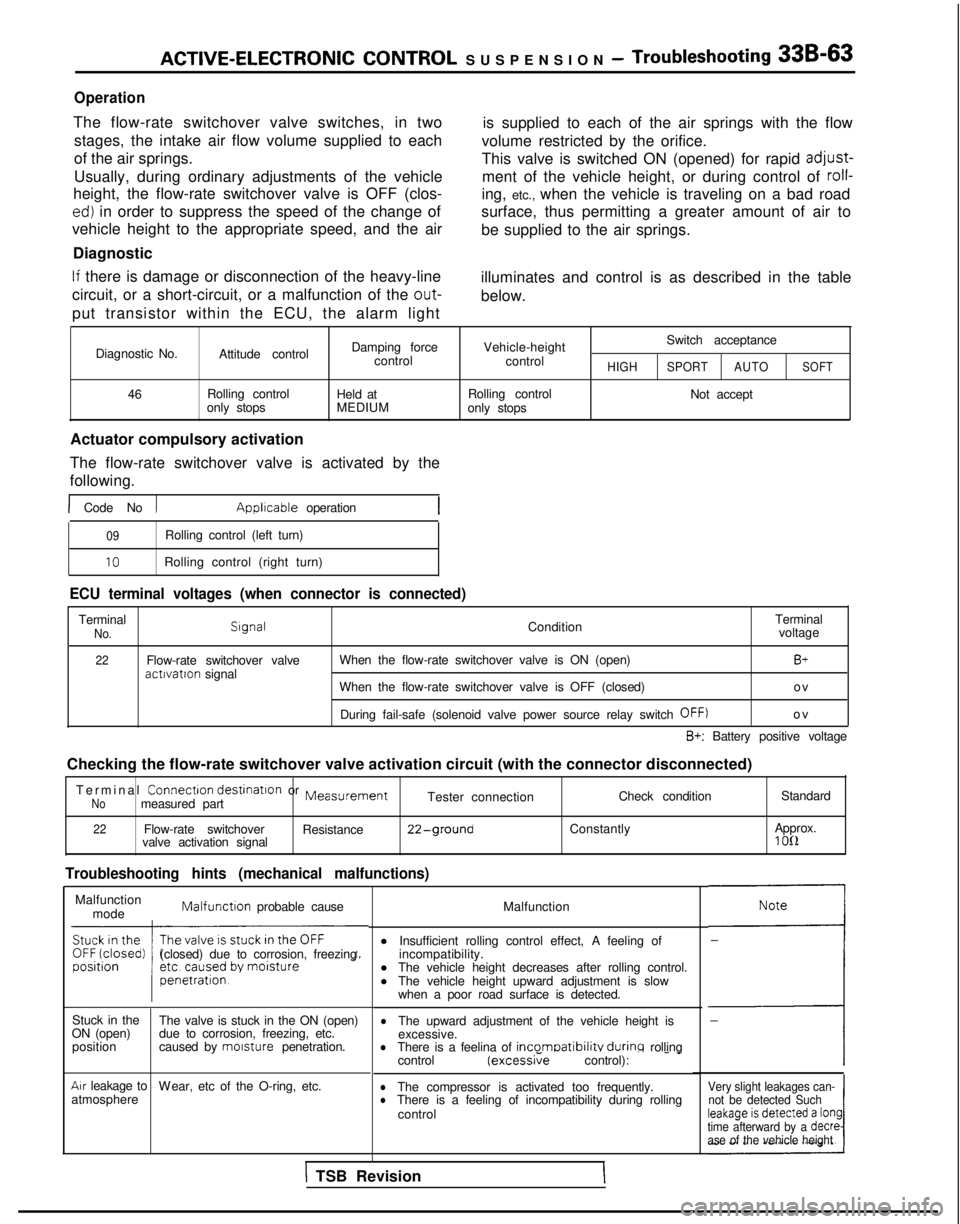
ACTIVE-ELECTRONIC CONTROL SUSPENSION - Troubleshooting 3%~63
Operation
The flow-rate switchover valve switches, in twostages, the intake air flow volume supplied to each
of the air springs.
Usually, during ordinary adjustments of the vehicle
height, the flow-rate switchover valve is OFF (clos-
ed) in order to suppress the speed of the change of
vehicle height to the appropriate speed, and the air
Diagnostic is supplied to each of the air springs with the flow
volume restricted by the orifice.
This valve is switched ON (opened) for rapid
adjust-
ment of the vehicle height, or during control of roll-
ing, etc., when the vehicle is traveling on a bad road
surface, thus permitting a greater amount of air to
be supplied to the air springs.
If there is damage or disconnection of the heavy-line illuminates and control is as described in the table
circuit, or a short-circuit, or a malfunction of the out-
below.
put transistor within the ECU, the alarm light
Switch acceptance
Diagnostic No. Attitude control Damping force
Vehicle-height
control control
HIGHSPORT AUTOSOFT
46 Rolling control
Held at Rolling control
Not accept
only stops MEDIUM
only stops
Actuator compulsory activation
The flow-rate switchover valve is activated by the
following.
1 Code No 1 Applrcable
operation
09Rolling control (left turn)
10Rolling control (right turn)
ECU terminal voltages (when connector is connected)
TerminalNo.SrgnalCondition Terminal
voltage
22Flow-rate switchover valve actrvation
signal When the flow-rate switchover valve is ON (open)B+
When the flow-rate switchover valve is OFF (closed)
o
v
During fail-safe (solenoid valve power source relay switch
OFF)o
v
B+: Battery positive voltage
Checking the flow-rate switchover valve activation circuit (with the co\
nnector disconnected) Terminal Connectron
destinatron
or
MeasurementNomeasured part Tester connection
Check condition
Standard
22Flow-rate switchover
Resistance22-groundConstantly Approx.
valve activation signal1 OIL
Troubleshooting hints (mechanical malfunctions)
Malfunction mode Malfunctron
probable cause
(closed) due to corrosion, freezing
Stuck in the The valve is stuck in the ON (open)
ON (open) due to corrosion, freezing, etc.
position caused by morsture
penetration.
Arr leakage to
W
ear, etc of the O-ring, etc.
atmosphere Malfunction
l Insufficient rolling control effect, A feeling of
incompatibility.
l The vehicle height decreases after rolling control.
l The vehicle height upward adjustment is slow
when a poor road surface is detected.
lThe upward adjustment of the vehicle height is
excessive.
lThere is a feelina of incomoatibilitv durinq rolling
control (excessi;e control): - -
lThe compressor is activated too frequently.lThere is a feeling of incompatibility during rolling
control
“i
4
-
Very slight leakages can-not be detected Such
time afterward by a
decre
ase of the vehicle height
\ TSB Revision
Page 1004 of 1273
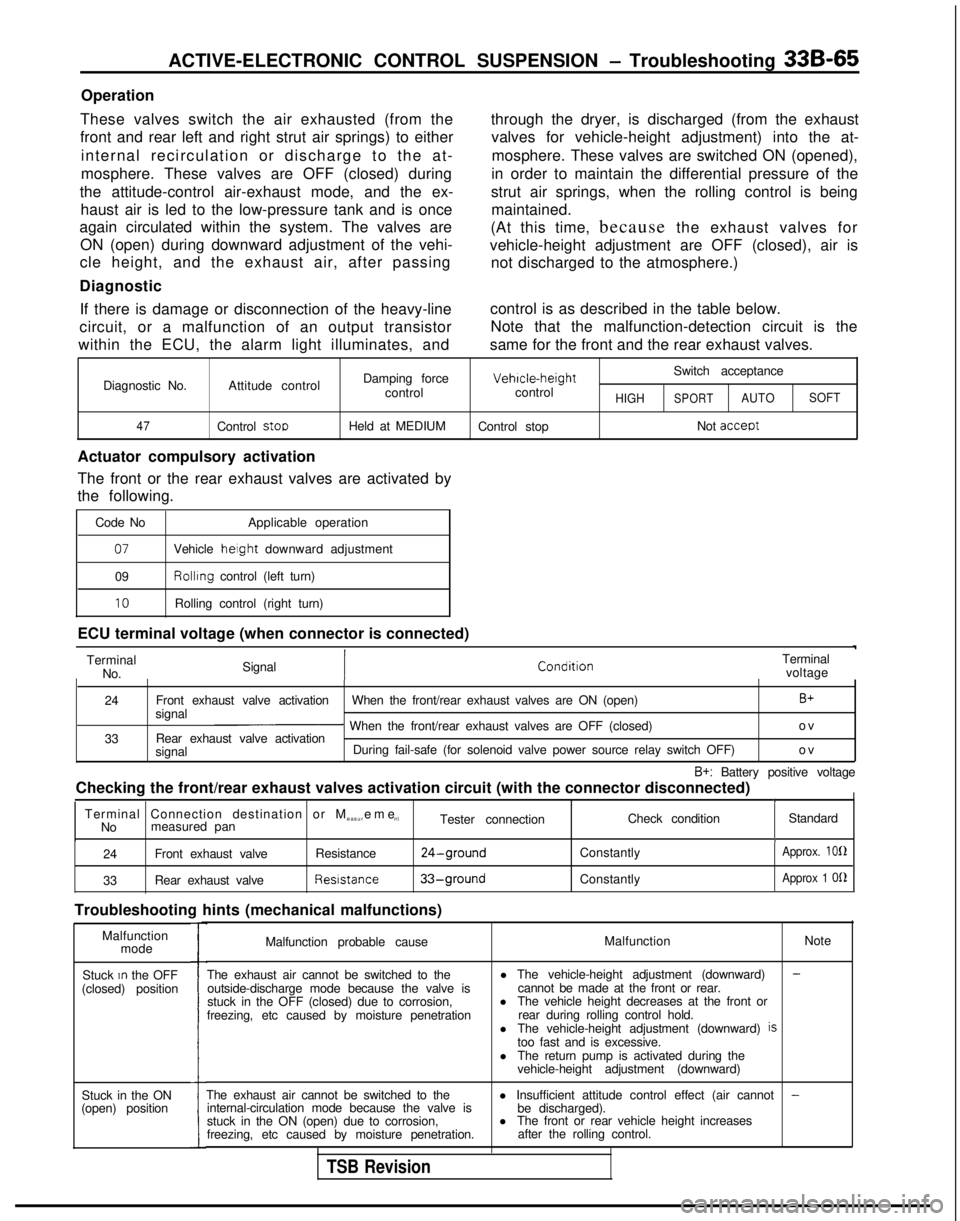
ACTIVE-ELECTRONIC CONTROL SUSPENSION - Troubleshooting 33B-65
Operation
These valves switch the air exhausted (from the
front and rear left and right strut air springs) to either internal recirculation or discharge to the at-
mosphere. These valves are OFF (closed) during
the attitude-control air-exhaust mode, and the ex- haust air is led to the low-pressure tank and is once
again circulated within the system. The valves are
ON (open) during downward adjustment of the vehi-
cle height, and the exhaust air, after passing
Diagnostic through the dryer, is discharged (from the exhaust
valves for vehicle-height adjustment) into the at-
mosphere. These valves are switched ON (opened),
in order to maintain the differential pressure of the
strut air springs, when the rolling control is being maintained.
(At this time, because the exhaust valves for
vehicle-height adjustment are OFF (closed), air is not discharged to the atmosphere.)
If there is damage or disconnection of the heavy-line control is as described in the table below.
circuit, or a malfunction of an output transistor Note that the malfunction-detection circuit is the
within the ECU, the alarm light illuminates, and same for the front and the rear exhaust valves.
Damping force Vehrcle-height
Switch acceptance
Diagnostic No. Attitude control
controlcontrol
HIGHSPORTAUTOSOFT
47
Control stooHeld at MEDIUM Control stop Not acceot
Actuator compulsory activation
The front or the rear exhaust valves are activated by
the following.
Code No Applicable operation
07Vehicle height downward adjustment
09 Rollrng
control (left turn)
10Rolling control (right turn)
ECU terminal voltage (when connector is connected) Terminal No. Signal Terminal
voltage
24
33 Front exhaust valve activation
When the front/rear exhaust valves are ON (open)
B+signal~ When the front/rear exhaust valves are OFF (closed) o
v
Rear exhaust valve activation
signal During fail-safe (for solenoid valve power source relay switch OFF)
ov
B+: Battery positive voltage
Checking the front/rear exhaust valves activation circuit (with the con\
nector disconnected)
II ITerminal Connection destination or M
easurem
e
nt
No measured pan Tester connection
Check condition
Standard
I
24Front exhaust valve Resistance24-ground
33Rear exhaust valve Resistance33-ground
Troubleshooting hints (mechanical malfunctions)
Constantly
Constantly
Approx. 100
Approx 1
OQ
Malfunction mode
Stuck
In the OFF
(closed) position
Stuck in the ON
(open) position
I
Malfunction probable cause Malfunction
Note
The exhaust air cannot be switched to the outside-discharge mode because the valve is
stuck in the OFF (closed) due to corrosion,
freezing, etc caused by moisture penetration l The vehicle-height adjustment (downward)
-cannot be made at the front or rear.
l The vehicle height decreases at the front or
rear during rolling control hold.
l The vehicle-height adjustment (downward)
istoo fast and is excessive.
l The return pump is activated during the
vehicle-height adjustment (downward)
The exhaust air cannot be switched to the l Insufficient attitude control effect (air cannot
-internal-circulation mode because the valve is
be discharged).
stuck in the ON (open) due to corrosion, l
The front or rear vehicle height increases
freezing, etc caused by moisture penetration. after the rolling control.
TSB Revision
Page 1006 of 1273

ACTIVE-ELECTRONIC CONTROL SUSPENSION - Troubleshooting 33B-67
Operation
The front air-supply valves are switched ON (open-
ed) for air supply to the left and right strut air springs
during attitude control and during vehicle-height
ad-
justment upward.
Diagnostic
If there is damage or disconnection of the heavy-line
circuit, or a malfunction of an output transistor
within the ECU, the alarm light illuminates, and Usually, and during air exhaust, these valves are
OFF (closed).
Note that a check valve is provided in these valves in
order to prevent reverse flow of the air.
control is as described in the table below. Note that the malfunction-detection circuit is the
same for the rear air-supply valves.
Diagnostic No. Attitude control Damping force
control Vehicle-height
control
HIGH
Switch acceptance
SPORT AUTOSOFT
51Control stop1 Held at MEDIUM
Control stop Not acceptI
Actuator compulsory activation
The front air-supply valves are activated by the
following
.
CodeNo
~
Applicable operation
I0
8 1
Vehicle herght upward adjustment
I
I09i Rolling control (left turn)I
L10Rolling control (right turn)I
ECU terminal voltage {when connector is connected)
TerminalNoSignal Conditron’ Termina
l
voltage
21Front atr-supply
valve
activation signal When the front air-supply valves are ON (open)B+
When the front arr-supply valves
are OFF (closed) ov
During fail-safe (for solenoid valve power source relay switch
OFF]o
v
B+: Battery positive voltage
Checking the front air-supply valve activation circuit (with the connec\
tor disconnected)
Terminal Connection destination or M easurement
No.measured part Tester connection
Check conditionStandard
21Front air-supply valve Resrstance
21 -ground
Constantly Approx. 1011
Troubleshooting hints (mechanical malfunctions)
Malfunction
mode Malfunction probable cause
MalfunctionNote
l Insufficient control of rolling and braking dive
position due to corrosion, freezing, etc lThe front vehicle-height decreases after rolling
caused by morsture
penetration
control.
Stuck in the Air supply cannot be stopped
ON (open) The front vehicle-height increases and the body tilts
-because the valve is stuck in the ON
to one sideposrtion
(open) due to corrosron.
freezing,
etc. caused by morsture
penetratron.
Air leakage at Valve seat IS worn,
l When left as is, the front
vehrcle-height increases.Diagnostic No.56
the valvel The front vehicle-height downward adjustment output
seat frequency increases.
Arr leakageW
ear, etc of the O-ring, etc.
lWhen left as IS. the front vehicle-height decreases.Very slight leakages can-to
l not be detected Such
atmosphere Air is not accumulated in the high-pressure tank.lThe compressor is activated too frequently.leakage is detected a longtime
afterward by a decre-
ase of the vehicle height
TSB Revision